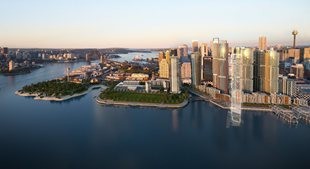Bob Nation, an architect with over 40 years experience, was earlier this year appointed design director for Barangaroo.
Nation, with design advisors Karl Fender, Keith Cottier and Richard Nugent, will provide design advice to the Barangaroo Delivery Authority regarding buildings proposed by Lend Lease, as well as for other parts of Barangaroo.
Architecture and Design spoke to Nation about what he hopes to achieve on the Barangaroo Authority, what Australia could learn from Dubai and why the Sydney Myer Asia Centre at Melbourne University is his favourite building.
What do you hope to achieve in your position at Barangaroo?
Barangaroo is singularly the most important major project in construction in Sydney today. The opportunity to be involved in the design excellence outcomes for this project and its broader context is an amazing opportunity.
My role is to consider propositions in pursuit of design excellence both in built form and the realisation of a unique and exciting public domain. The project will have a construction duration of some seven to eight years and to be involved in the beginnings of this outcome is a most exciting prospect.

You have recently been living in Hong Kong. What is the country's approach to architecture?
I lived in Hong Kong for 20 years from 1981 and returned to Australia in 1999. I have continued to have a close relationship with Hong Kong, its architecture and outcomes, since that time relocating there in 2011.
Architecture in Hong Kong is controlled by the development constraints of individual sites and with the exception of some current new master planning projects, such as the Kowloon cultural district, the site lease controls dictate the outcome and the form of the building with the architecture being derived from the detail and creative thought working within those tight constraints.
What insights and learnings will you be bringing back to Australia from Hong Kong?
Living in Hong Kong, one really experiences the nature of high rise and high density living and the opportunities and outcomes of extremely dense urban form with a resultant very active public domain. So if there’s anything that I have learnt from Hong Kong it is the positive/active public domain of an urban fabric and the design of high rise housing form within very dense controls and outcomes.
You have also worked in Dubai. How do you think Dubai approaches design?
I lived and worked in Dubai from 2007 to beginning of 2011 and found Dubai to be completely the antithesis of the Hong Kong experience. There is very little appropriate master planning, with projects being very site specific without the commitment to broader urban outcomes. It is a city experienced from the car with little pedestrian connectivity. The climate, of course, has much to do with this, with the temperature range being from 18 to 20 degrees in the so-called winter to 50 degrees plus in the summer. These extremes are further exacerbated by sand storms and a general lack of connective urban tissue.
Is there anything Australia could learn from Dubai design?
I suspect that the most interesting elements of the Dubai experience relate to individual propositions in terms of some built form and the extreme sculptural outcomes which have little commitment to commercial efficiency, but quite often relate only to the nature of the built form itself, making extreme statements that range from the most conservative historic references to the fluid geometries of the digital age.
You have over 40 years experience in the industry. What has been some of the most important lessons you've learnt over the years?
I guess the most fundamental thing I have learnt over my years in architecture is that one must always look at individual architectural opportunities beyond the limits of its specific site. It is necessary to consider context, connectivity, relationships and opportunities that may be generated from an individual project and look at their influence on better outcomes for the broader urban circumstance.
My work over these years started with houses in Hobart, through high rise in Hong Kong, to the design of new cities and universities, so the range of work has been very urban in its context. Working internationally has provided me with a unique story and rich experience.
You have worked on some iconic buildings. What building are you most proud of and why?
One of my favourite projects is the Sydney Myer Asia Centre at Melbourne University, which is a low rise building which helps to knit and connect elements of the university on Swanson Street in Melbourne and helps create new internal people places within the university itself. It is a five-storey project, but one of the most wonderful experiences of this building was the incorporation of public art into the building fabric with my dear friend and sculptor Akio Makigawa.

Sydney Myer Asia Centre. Image: Skyscrapercity

